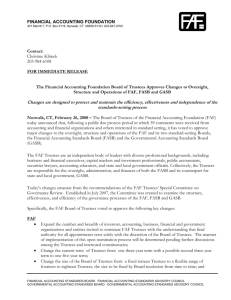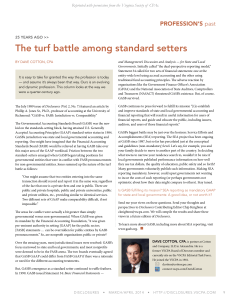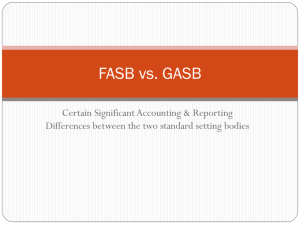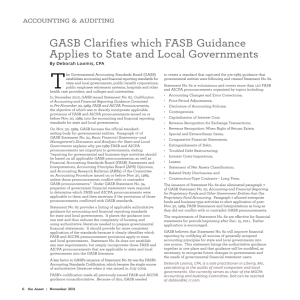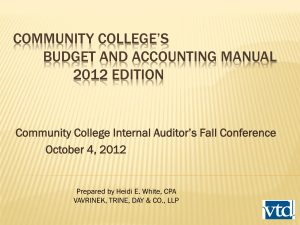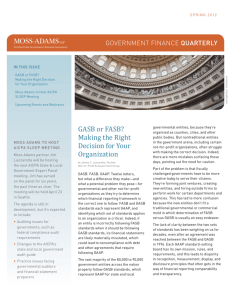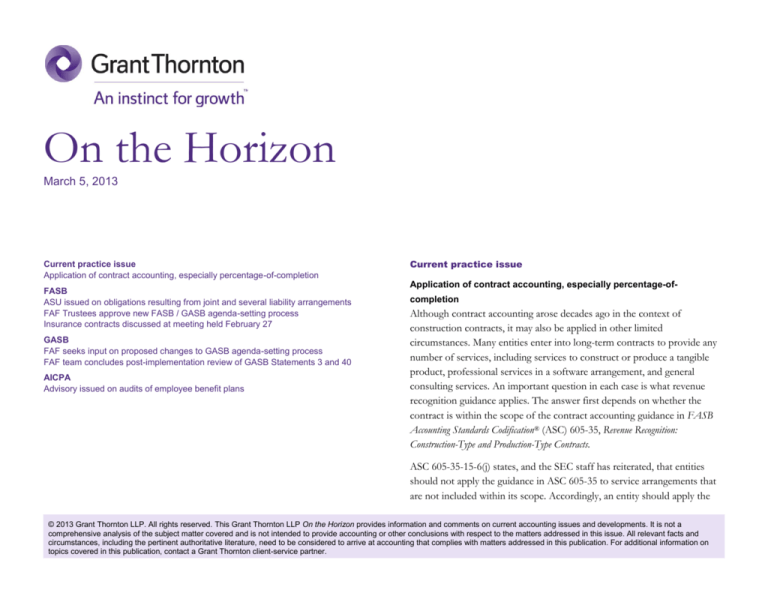
On the Horizon
March 5, 2013
Current practice issue
Application of contract accounting, especially percentage-of-completion
FASB
ASU issued on obligations resulting from joint and several liability arrangements
FAF Trustees approve new FASB / GASB agenda-setting process
Insurance contracts discussed at meeting held February 27
GASB
FAF seeks input on proposed changes to GASB agenda-setting process
FAF team concludes post-implementation review of GASB Statements 3 and 40
AICPA
Advisory issued on audits of employee benefit plans
Current practice issue
Application of contract accounting, especially percentage-ofcompletion
Although contract accounting arose decades ago in the context of
construction contracts, it may also be applied in other limited
circumstances. Many entities enter into long-term contracts to provide any
number of services, including services to construct or produce a tangible
product, professional services in a software arrangement, and general
consulting services. An important question in each case is what revenue
recognition guidance applies. The answer first depends on whether the
contract is within the scope of the contract accounting guidance in FASB
Accounting Standards Codification® (ASC) 605-35, Revenue Recognition:
Construction-Type and Production-Type Contracts.
ASC 605-35-15-6(j) states, and the SEC staff has reiterated, that entities
should not apply the guidance in ASC 605-35 to service arrangements that
are not included within its scope. Accordingly, an entity should apply the
© 2013 Grant Thornton LLP. All rights reserved. This Grant Thornton LLP On the Horizon provides information and comments on current accounting issues and developments. It is not a
comprehensive analysis of the subject matter covered and is not intended to provide accounting or other conclusions with respect to the matters addressed in this issue. All relevant facts and
circumstances, including the pertinent authoritative literature, need to be considered to arrive at accounting that complies with matters addressed in this publication. For additional information on
topics covered in this publication, contact a Grant Thornton client-service partner.
On the Horizon March 5, 2013
percentage-of-completion method only if a contract is determined to be within
the scope of ASC 605-35. If a long-term service contract is outside the scope of
ASC 605-35, the entity should apply a proportional performance or a completed
performance model to account for the service arrangement. Under a
proportional performance model, costs are generally expensed as incurred, and,
as a result, applying the proportional performance model will not result in a
constant margin percentage as under the percentage-of-completion method.
Cost-plus-fixed-fee government contracts and other cost-plus-fee
contracts, as well as contracts for products and services that are
customarily billed as shipped or rendered
Services that do not produce a tangible product as the principal
intended result
Examples
Contracts within the scope of ASC 605-35
ASC 605-35-15-3 lists the types of arrangements within the scope of contract
accounting, which are generally construction-type or production-type contracts
where services are performed to customer specifications. In addition, contract
accounting is required for arrangements covering the delivery of software or a
software system that includes significant production, modification, or
customization of the software. Separate contracts to provide services essential
to the construction or production of tangible property (for example, design,
engineering, procurement, and construction management) should also be
accounted for using the guidance of ASC 605-35. Third-party requirements
(such as government or regulatory agency) are considered customerspecifications when evaluating the applicability of contract accounting to an
arrangement.
Contracts outside the scope of ASC 605-35
Although entities must use judgment to appropriately identify when contract accounting should be
applied, the following examples illustrate how to apply the scope guidance in ASC 605-35:
planning, migration, integration, and support services, as well as the provision of hardware
and software. Entity A is a reseller of the hardware and software, and the solutions do not
require customizing or modifying the software. The planning phase of the arrangements
includes a customer needs assessment. The entity uses the results of the needs
assessment to design a customized solution for the customer.
Conclusion: These arrangements are not within the scope of ASC 605-35. While each
solution is customer-specific, Entity A is providing services to customers that do not result in
the construction of a tangible asset. As a result, Entity A should apply either a proportional
performance or a completed contract model to these arrangements.
ASC 605-35-15-6 lists certain arrangements where contract accounting is not
considered appropriate, including the following transactions:
Sales of goods from inventory or sales of homogenous goods from
continuing production
Sales of goods produced in a standard manufacturing operation in the
ordinary course of business and marketed using the vendor’s regular
marketing channels, even if the products are made to customer
specifications
Service provided over an extended period of time (for example, health club
memberships)
Magazine subscriptions
Entity A provides communications network solutions. Typical arrangements include
Entity B is a general contractor whose projects primarily include designing and subsequently
building roads, including the related site-preparation work. Entity B personnel provide
project management services, and the construction services are subcontracted to third
parties.
Conclusion: As the general contractor, Entity B is the primary obligor in the arrangements
and would apply contract accounting, even though it subcontracts the construction services
to third parties.
Entity C designs and produces large simulators used in the commercial transportation
industry for training and certification purposes. The simulators are produced to customer
specifications in a standard manufacturing process. Entity C integrates the unique
characteristics of a customer’s equipment in the simulators through customized software.
Conclusion: Because Entity C provides significant software customization services, contract
2
On the Horizon March 5, 2013
accounting should be applied to these arrangements, even though the simulators are
produced in a standard manufacturing process.
FASB
All decisions reached at Board meetings are tentative and may be changed at future meetings.
Decisions are included in an Exposure Draft only after a formal written ballot. Decisions
reflected in Exposure Drafts are often changed in redeliberations by the Board based on
information received in comment letters, at public roundtable discussions, and from other
sources. Board decisions become final after a formal written ballot to issue a final Accounting
Standards Update.
ASU issued on obligations resulting from joint and several liability
arrangements
Recently, the FASB issued Accounting Standards Update (ASU) 2013-04,
Obligations Resulting from Joint and Several Liability Arrangements for Which the Total
Amount of the Obligation Is Fixed at the Reporting Date ‒ a consensus of the FASB
Emerging Issues Task Force.
A summary of the ASU can be found in the January 22 edition of the On the
Horizon.
FAF Trustees approve new FASB / GASB agenda-setting process
The Financial Accounting Foundation’s (FAF) Board of Trustees recently
approved a key change to the agenda-setting process for both the FASB and
GASB. A majority of the respective Board members, rather than the Board
chair alone, will now be required to approve decisions regarding project plans,
agenda setting, and the priority of projects. All future agenda decisions will be
voted on by Board members in public meetings. This change will provide
stakeholders with greater insight into the agenda decision process, including
feedback from stakeholders, the urgency of certain issues, and the availability of
Board resources.
Insurance contracts discussed at meeting held February 27
The following highlights are from the FASB’s February 27 discussions of its
project on insurance contracts.
Presentation in the statements of financial position and comprehensive
income
The Board affirmed its previous decision that an insurer would present
specified items in the statement of financial position for the building block
approach and the premium allocation approach. In addition, the Board
tentatively decided that an insurer would also present specified items in the
statement of comprehensive income.
Disclosures
The FASB reached tentative decisions about specific disclosures for
insurance contracts that would be required in both annual and interim
financial statements.
GASB
FAF seeks input on proposed changes to GASB agenda-setting
process
Recently, the FAF’s Board of Trustees released a Request for Comment,
GASB’s Scope of Authority: Proposed Changes to Agenda-Setting Process, which
proposes revisions to the agenda-setting process of the GASB to assist the
Trustees in assessing the scope of the GASB’s standard-setting activity.
In May 2011 the FAF authorized an independent academic study to explore
the purposes of financial accounting and reporting by state and local
governments and to provide insights to the Trustees on how the GASB can
best serve stakeholders. The study revealed a lack of consensus about the
appropriate scope of the GASB’s activities and involvement in government
accountability reporting. Accordingly, the Trustees would like stakeholder
input on the proposed GASB agenda-setting process.
The comment period ends April 30, 2013.
3
On the Horizon March 5, 2013
FAF team concludes post-implementation review of GASB Statements 3
and 40
Recently, the FAF issued a Post-Implementation Review Report of GASB
Statement 3, Deposits with Financial Institutions, Investments (including Repurchase
Agreements), and Reverse Repurchase Agreements, and Statement 40, Deposit and
Investment Risk Disclosures. These statements both require note disclosures about
deposit and investment risks by state and local governments, and Statement 3
also provides accounting guidance for repurchase and reverse repurchase
agreements.
The review team reached an overall conclusion that Statements 3 and 40 achieve
their purpose and provide decision-useful information about deposit and
investment risk to creditors and other financial statement users. The team had
no significant standard-setting process recommendations.
In addition, the FAF announced that it will conduct a post-implementation
review of GASB Statement 10, Accounting and Financial Reporting for Risk
Financing and Related Insurance Issues, and Statement 30, Risk Financing Omnibus
‒ an amendment of GASB Statement No. 10.
AICPA
Advisory issued on audits of employee benefit plans
Recently, the AICPA’s Employee Benefit Plan Audit Quality Center issued
Plan Advisory, Employee Benefit Plans ‒ Financial Statement Audits, to provide
plan sponsors, plan administrators, and trustees with a better understanding
of, and insights into, the independent audit of the financial statements of an
employee benefit plan.
4


